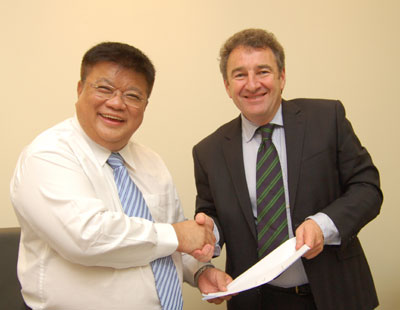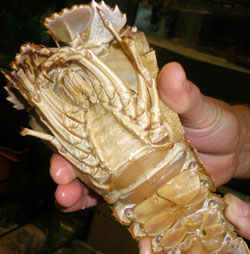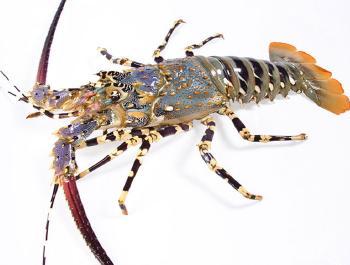
FARMING LOBSTERS has always been challenging, but Oceanus’ Aussie aquaculture technology partner recently broke new ground in achieving commercial viability for its lobster species.
Just as the abalone is a prized delicacy in Asia, so is the lobster is a prized delicacy in Europe and North America.
However, high demand plus the absence of aquaculture has led to all of the world’s wild lobster fisheries being either fully exploited or in decline.
Yesterday afternoon, Oceanus, the world's largest land-based abalone farm operator, inked a deal with Lobster Harvest to jointly farm slipper lobsters, for which the leading Aussie lobster aquaculture technology company has successfully propagated at commercially viable survival rates.
The current supply of slipper lobsters (commonly known as crayfish in Singapore) are frequently stale because it is harvested together with fish even though crustacean deterioration is much more rapid.

Wanting to replicate Oceanus’ successful business model in abalone aquaculture, executive chairman Dr Ng Cher Yew now wants to supply fresh and affordable live slipper lobsters to restaurants in China as well as for export.
He wants to tap on China’s rapidly increasing affluence, which makes it a high growth market for luxury consumption.
”I expect gross margins to be comparable to our abalone farming business,” said Dr Ng during the signing ceremony yesterday.
While the farming methods are quite similar, the period to grow the slipper lobsters to a marketable size is about 14 to 15 months, shorter than abalones, which require about 36 months.
There is also a huge market in North America and in Europe for processed lobster meat, he adds.
Lobster Harvest is Australia’s leading company in lobster aquaculture technology, and has developed unique hatchery technology at its facilities in Western Australia after 10 years on lobster propagation R&D.
It was spun off from MG Kailis, one of Australia’s largest private marine and seafood companies which pioneered Western Australia’s lobster industry half a century ago.
And Australia happens to be one of the biggest exporters of lobsters into Hong Kong and China, accounting for 32% of frozen lobster imports and 61% of live or fresh lobster imports there in 2008.
“Through MG Kailis, we have extensive wholesale and retail channels in western countries, and Oceanus brings to us the China market“ said Terry Burnage, general manager of Lobster Harvest, who was in town to ink the deal.
”The slipper lobster has great potential to be the next big thing in seafood once the grow-out is developed at a mass scale,” he adds.
Under the deal, Oceanus will invest A$1 million for an approximate 6.5% stake in Lobster Harvest, plus option to acquire additional shares.
In addition, the leading abalone farmer will invest A$2 million in two 50:50 JVs with Lobster Harvest, one based in Singapore and the other based in the PRC.

In exchange for Oceanus’ A$3 million investment, the lobster aquaculture technology company will contribute A$1 million and grant the Singapore JV the license to breed slipper lobsters in the PRC using its proprietary technology.
The Singapore JV will conduct R&D on slipper lobster aquaculture production in collaboration with Tropical Marine Science Institute of the National University of Singapore.
The PRC JV will set up hatchery production in the PRC, in locations with appropriate water temperature, water quality and salinity.
Lobster Harvest is also developing propagation technology for a premium lobster species, the Spiny Tropical Rock Lobster, and expects its R&D to be commercially viable within 3 years.
Under the same deal, Oceanus will have non-exclusive, first right of refusal to the hatchery propagation technology for the premium species, which retails by weight at two to three times the price of slipper lobsters.
The Spiny Tropical Rock Lobster is used in Japanese cuisine for sashimi.
OCEANUS | |
| Stock price | 31 cts |
| Market cap | S$625.1 m |
| 52-week high/low | 47 / 30 cts |
| Bloomberg est PE | 10.0 X |
| Operating margin | 61.5% |
| Net margin | 47.8% |
Bloomberg, 16 Jul 2010 | |
Oceanus does not expect the collaboration agreement to have any material impact on its earnings in FY2010.
It looks as though the seafood farmer is on a rebound after hitting a recent snag when it had to close down 6 outlets in its Ah Yat Tian Xia restaurant chain in Beijing and Shanghai due to escalating rentals, but the remaining 15 restaurants are expected to break even or be profitable.
In its report dated 6 Jul, OCBC Investment Research had a ‘Hold’ rating on Oceanus with fair value at 32 cents.





